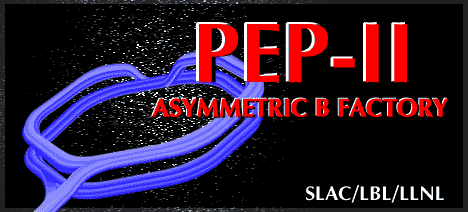 07/01/97 Update
07/01/97 Update
 07/01/97 Update
07/01/97 Update
PEP-II Update July 1, 1997
The June PEP-II engineering run ended this morning with positron transport studies. The HER beam tests ended yesterday morning.
Yesterday afternoon (June 30) positrons at 3 GeV were extracted from the linac, transported to the end of the linac, and seen for the first time on a screen at the beginning of the south match which is downstream of the 30 degree bend in the injection line and 100 m from the LER injection point. Thus, beam has traversed every meter of available injection line. The positron injection line position and profile monitors were commissioned as well. The injection trajectories have positions of about 2-3 mm rms. All very nice achievements for Dave Schultz, Rich Iverson, and ... . Positron and electron bypass line studies in the linac tunnel will continue in July and August as the SLC program allows.
The HER studies ended with all goals achieved. A beam of 60 mA was stored in 18 bunches limited by multibunch instabilites and a hot bellows module. (There is one unshielded bellows module in HER which will get replaced in July.) Many other bunch patterns were tried; all had current limits in the 40 to 60 mA range. Multibunch mode spectra were taken for downtime study. No evidence of dust-macroparticle collection by the beam has been seen so far.
The timing system, as implemented by Marc Ross, Mike Ronan (LBL), Vinod Bharadwaj, and others, worked very well allowing any desired bunch pattern to be setup in a few minutes. Uniform spacing, bunch trains, every bucket, up to 1000 buckets, ... were all tried and successful with the constraints of 1 Hz injection and the 40-60 mA limit.
The coupling in the ring was measured to be about 5% and with skew quadrupole adjustments reduced to about 0.8%.
The longitudinal bunch-by-bunch feedback under John Fox, Ray Larsen, Dmitry Teytelman and friends was turned on and beam modes could be excited and suppressed as desired. Initial line spectra data were taken.
The transverse bunch-by-bunch feedback system under Walter Barry (LBL) and John Corlett (LBL) was also turned on and timed to the beam. This system could also damp and excite the bunches in the beam. The transverse kickers were also used to measure the betatron tunes.
Both feedbacks were not yet in a state to be left unattended for the multibunch injection tests (above) but will be put to full test in September when we intend to push towards 500 mA.
The beam diagnostics worked very well during the run. The DCCT and bunch-by-bunch current monitors and software developed by Jim Hinkson (LBL), Mike Chin (LBL) and Ron Chestnut worked very well. The beam positon monitors (Steve Smith, Tom Himel, Linda Hendrickson,...) worked on day one and achieved 25 micron resolutions by the end of June with 10 mA or so stored. The tune monitor (Alan Fisher, Bob Stege, ...) allowed beam spectra to be carefully studied.
In the temporary interaction region, background monitors (Tom Mattison, Walter Toki (UCol), Sandrine Emery (Saclay), Pat Barchat, ..., have taken initial data to be compared with computer background simulations.
The injection lines and the HER machine have been very stable and robust. This robustness makes commissionig much easier. In fact, several linac unscheduled downs were bridged by stored beam in the HER.
Finally, the tunnel is now open for two months to install the LER so that initial part-turn injection tests under Michael Zisman can start in mid-fall. Also, by then the HER full five RF stations and the current sheet septum will be installed so that Uli Wienands can push the HER parameters farther.
Thanks again for everyone's help and hard work. It's been fun and a pleasure.
Cheers, John Seeman
Suggestions to: John Seeman
[PEP-II Commissioning Updates] [PEP-II Home Page] [BABAR Detector Home Page] [SLAC Home Page]
Page owner: achan